#north american wildflowers
Text
Virginia Bluebells (Mertensia virginica)
Blue flowers are relatively rare. Most incline to violet or else are quite small. But Virginia bluebells are a striking exception. All my photos from my garden, unedited.


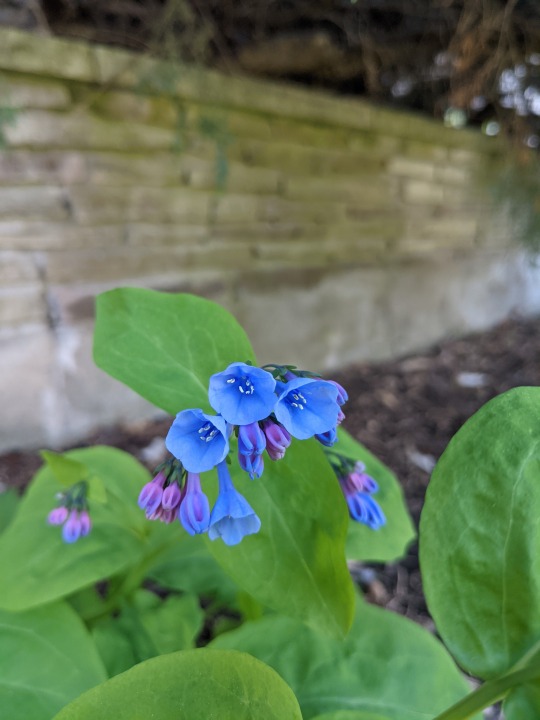



I'm not kidding. They really are that blue naturally. They bloom in May. Then they slowly decline and the entire plants are gone above soil by the summer. Only to reappear the following spring! The shoots and flower buds are edible. You don't want to take too much, though. As spring ephemerals, they need the energy they make with their leaves during their short growing period. The short bloom period is also why I don't have more photos of them. They don't even bloom every year.
#photography#my photos#blackswallowtailbutterfly#Virginia bluebells#Mertensia virginica#flowers#blue flowers#wildflowers#gardening#native species#North American native plants#edible wild plants#my garden#native plants of Ontario and the northeastern USA#spring ephemerals
15 notes
·
View notes
Text




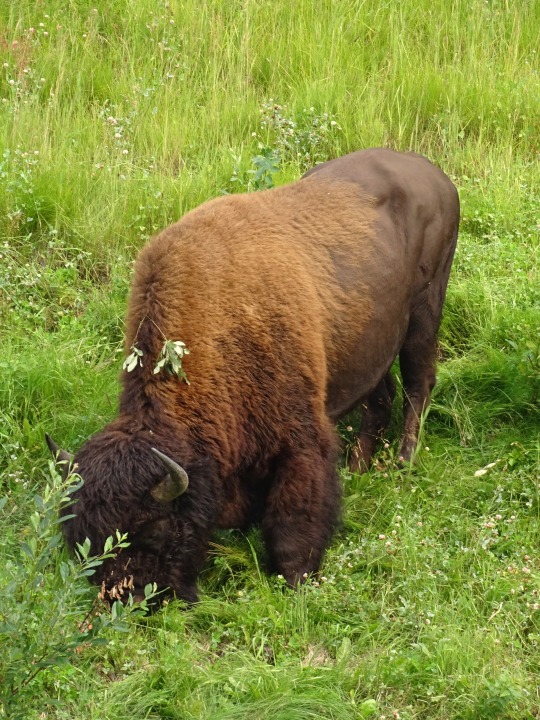

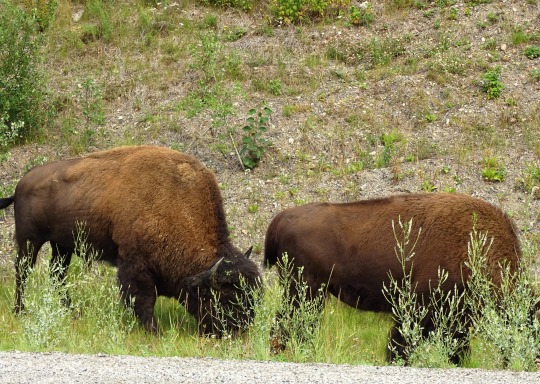
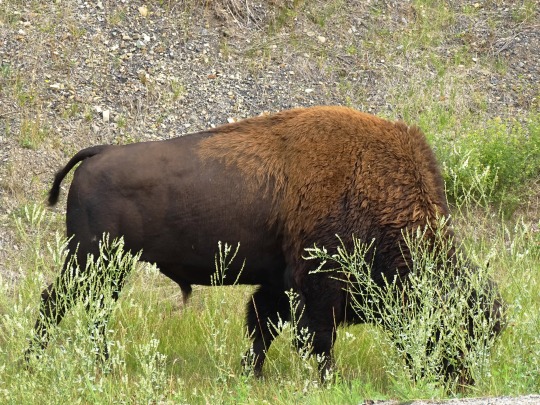
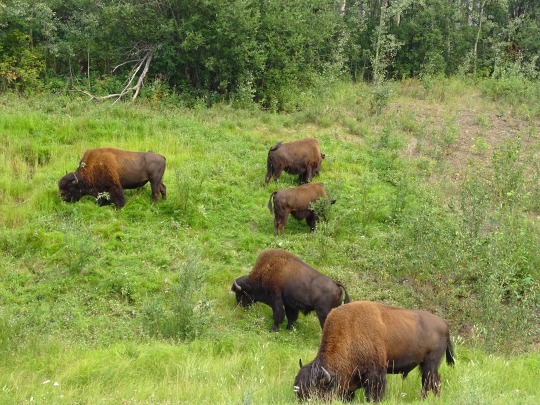
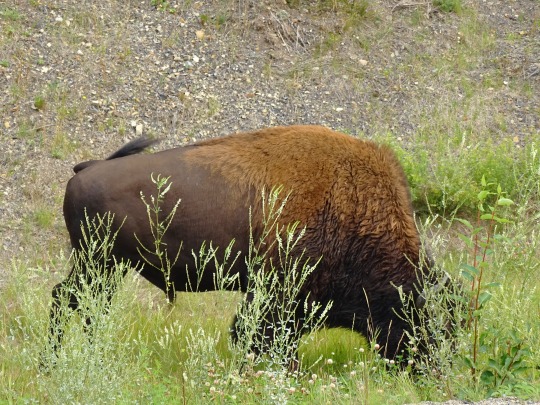
Wood Bisons, YT (No. 3)
The herd currently has a total population around 2,500, largely as a result of conservation efforts by Canadian government agencies. In 1988, the Committee on the Status of Endangered Wildlife in Canada changed the subspecies' conservation status from "endangered" to "threatened", where it remains.
On June 17, 2008, 53 wood bison were transferred from Alberta's Elk Island National Park to the Alaska Wildlife Conservation Center in Anchorage, Alaska. There they were to be held in quarantine for two years and then reintroduced to their native habitat in the Minto Flats area near Fairbanks, but this plan was placed on hold. In May 2014, the U.S. Fish and Wildlife Service published a final rule allowing the reintroduction of a "non-essential experimental" population of wood bison into three areas of Alaska. As a result, the Alaska Department of Fish and Game introduced the first herd of 100 animals to the Innoko River area in western Alaska in spring 2015.
Currently, about 7,000 wood bison remain in wildernesses within the Northwest Territories, the Yukon, British Columbia, Alberta, and Manitoba.
Source: Wikipedia
#Wood Bison#Alaska Highway#travel#original photography#vacation#landmark#landscape#countryside#summer 2023#flora#nature#Canada#Alaska-Canadian Highway#ALCAN Highway#Alaskan Highway#the North#Yukon#tourist attraction#fauna#wildlife#animal#grazing#meadow#Bison bison athabascae#mountain bison#wood buffalo#mountain buffalo#American bison#wildflower
8 notes
·
View notes
Text

Eastern Prairie White-Fringed Orchid (Platanthera leucophaea)
Eastern / Central USA
Status: Threatened
Threats: grazing, fire suppression, agriculture
#Not Like Other Flowers - a Complicated name for a Complicated flower#floral art#botanical art#artists on tumblr#north american plants#white flower#meadow flower#plant#flower#wildflower#usa#north america
8 notes
·
View notes
Text

i bet andre the giant loved this plant :')
My photo: September 2023
#obedient plant#Physostegia virginiana#botany#nature photography#pinkcore#wildflower photography#midwestern flora#north american flora#original photography on tumblr
3 notes
·
View notes
Text

Some Pollinator Appreciation
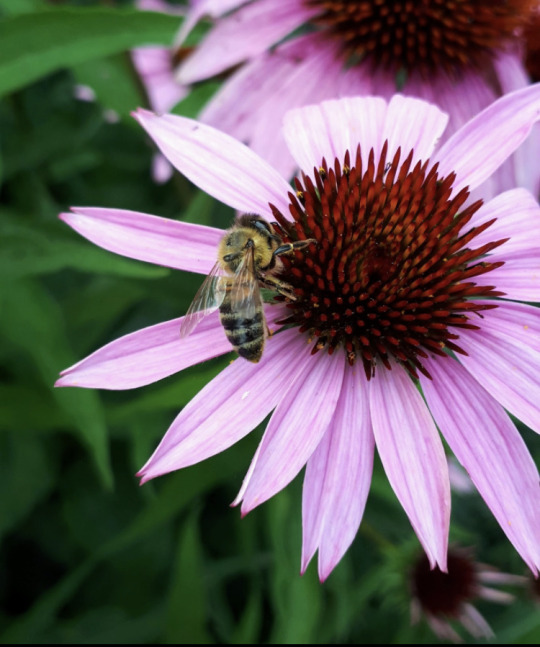

#flowers#bees#wasps#bumblebees#honeybees#insects#nature#entomology#I didn’t know purple coneflowers were native wildflowers to NA very cool#all of these are very common species but it’s still nice to see#there are more than just hymenopteran pollinators of course#purple echinacea#bombus impatiens#apis mellifera#apidae#dolichovespula arenaria#common aerial yellowjacket#vespidae#hymenoptera#north american species#introduced species#my photos
6 notes
·
View notes
Text
Here's a link you can hold onto in case you ever need to tell somebody why reintroducing predators into North American ecosystems is important
After decades of high deer populations, North American forests have lost much of their previous biodiversity. Any landscape-level recovery requires substantial reductions in deer herds, but modern societies and wildlife management agencies appear unable to devise appropriate solutions to this chronic ecological and human health crisis. We evaluated the effectiveness of fertility control and hunting in reducing deer impacts at Cornell University. We estimated spring deer populations and planted Quercus rubraseedlings to assess deer browse pressure, rodent attack, and other factors compromising seedling performance. Oak seedlings protected in cages grew well, but deer annually browsed ≥60% of unprotected seedlings. Despite female sterilization rates of >90%, the deer population remained stable. Neither sterilization nor recreational hunting reduced deer browse rates and neither appears able to achieve reductions in deer populations or their impacts. We eliminated deer sterilization and recreational hunting in a core management area in favor of allowing volunteer archers to shoot deer over bait, including at night. This resulted in a substantial reduction in the deer population and a linear decline in browse rates as a function of spring deer abundance. Public trust stewardship of North American landscapes will require a fundamental overhaul in deer management to provide for a brighter future, and oak seedlings may be a promising metric to assess success. These changes will require intense public debate and may require new approaches such as regulated commercial hunting, natural dispersal, or intentional release of important deer predators (e.g., wolves and mountain lions). Such drastic changes in deer management will be highly controversial, and at present, likely difficult to implement in North America. However, the future of our forest ecosystems and their associated biodiversity will depend on evidence to guide change in landscape management and stewardship.
The deer are literally eating all the tree saplings in a lot of areas so the forest is having the old trees die and no new trees grow, and they're eating all the rare wildflowers like orchids and trilliums.
Human hunting doesn't work, and sterilizing more than 90% of female deer doesn't work. The answers the researchers propose are regulated commercial hunting (basically, hunting deer in limited amounts so the meat can be sold just like farmed beef or pork) and reintroducing wolves and mountain lions.
"Wolves and mountain lions are dangerous!" Out of an estimated 458 deadly encounters with animals that occur in the U.S.A. yearly, an estimated 440 of them are fatal collisions with deer.
Next time there is some dumbass Republican trying to claim wolves don't need to be protected by the Endangered Species Act (yes, they're literally claiming that wolves are fully recovered when they don't even exist in the vast majority of their former range) have these links close at hand
860 notes
·
View notes
Text
If there's anyone out there that cares about flower language and symbolism like I do, I made an informal write-up some time ago about the in-game flowers (that you can put in your house) and the different symbolism that they can mean.
I included the symbolism for the in-game colors as well when they were available.
Also as a disclaimer these could be incorrect, have contrasting meanings, or have different meanings in different real-world cultures. White chrysanthemums (kiku) are usually a funeral flower in Japan for instance. (My Japanese professor once said they were a faux pas for her to receive in a bouquet!) So your mileage may vary!
This was simply a fun personal project I made for myself that I thought other people might enjoy as well! So here's a question to answer in the tags:
What flowers would your WoL have in their residence?
Arums (calla lily)
🔷magnificent beauty, feminine modesty
Brightlilies (easter lily)
🔷purity, refined beauty
🔷White: virginity, purity, majesty
🔷Pink: wealth and prosperity
🔷Red: warmth, desire
🔷Yellow: gaiety, falsehood, "I’m walking on air"
🔷Orange: hatred
Campanulas (bellflower)
🔷humility, constancy
Chrysanthemum
🔷cheerfulness, "You’re a wonderful friend"
🔷Red: I love you
🔷White: truth
🔷Yellow: slighted love
Cosmos
🔷harmony, peace, modesty, "the joys that love and life can bring", beautiful
Dahlias
🔷dignity, elegance
Daisies
🔷innocence, beauty
Lilies of the Valley
🔷return of happiness, sweetness, humility, purity
Oldrose
🔷Red: I love you, love, beauty, passion, romance
🔷Blue: mystery, attaining the impossible, love at first sight
🔷White: innocence and purity, "I am worthy of you", reverence
🔷Yellow: decrease of love, jealousy, friendship
Shroud Cherries (cherry blossom)
🔷spiritual beauty, a good education
Tulips
🔷perfect lover, fame
🔷Red: declaration of love, true love, eternal love, romantic love, "believe me"
🔷Yellow: hopeless love, unrequited love, brightness, sunshine
🔷White: ask for forgiveness, purity
🔷Purple: royalty
Hyacinths
🔷sports, games, rashness
🔷Purple: I am sorry, sorrow, "please forgive me"
🔷Red: play
🔷White: loveliness, "I’ll pray for you"
🔷Blue: constancy, sincerity
🔷Yellow: jealousy
Hydrangeas
🔷heartlessness, boastfulness, "You are cold"
Morning Glories
🔷love in vain, affection
Violas (violets)
🔷modesty, faithfulness
🔷Purple: daydreaming, "You occupy my thoughts"
🔷Blue: watchfulness, love
🔷White: candor, innocence
🔷Yellow: rural happiness
Byregotia (begonia?)
🔷Beware
Carnation
🔷fascination, love, distinction
🔷Red: "My heart aches for you", deep love, admiration
🔷White: sweet and lovely, innocence, pure love
🔷Yellow: "You have disappointed me", rejection, disdain
🔷Purple: capriciousness, changeable
Moth Orchid
🔷love, beauty, refinement, beautiful lady
Sweet Pea
🔷departure, good-bye, delicate pleasure, tender memory, blissful pleasure
Triteleia
🔷 They're a North American wildflower also called 'triplet lilies' or 'Ithuriel's spear' which is a reference to John Milton's epic English poem, Paradise Lost. It's about an angel sent by Gabriel to find Satan in the Garden of Eden. Satan, in the form of a toad, is introducing evil suggestions into the ear of Eve when Ithuriel pokes him with a spear. Satan then returns to his true form, "for no falsehood can endure Touch of Celestial temper, but returns Of force to its own likeness." It is to an unknown but imaginative scholar of English letters that we owe the common name of this plant.
Long story short, I can't find any symbolism for this one. Would make a possibly good Halone/Ishgard reference if you wanted to read into it, though!
#queue time#mine#ffxiv#tsuna has white brightlillies white daisies and red carnations in her house 🥺#with some white chrysanthemum and shroud cherries growing#and a yellow oldrose bouquet...#I should update them tbh
86 notes
·
View notes
Text

‘Diné: Our Survival Is Bound To Theirs’ is a zine curated by zinester and herbalist Kuwa Jasiri, featuring contributions from a range of Native Americans. Buy a copy here.
Featuring stories and resources, its cover is graced by Native American activist and all-round badass Katherine Smith, and the zine itself comes with a small packet of North American wildflower seeds 👊🏽 🌿
#zine#zines#fanzines#fanzine#native american zines#native american fanzines#Diné#Diné zines#Diné fanzines#Navajo#Navajo zines#Navajo fanzines#Katherine Smith#Kuwa Jasiri#wildflowers#Zines about Native Americans#Fanzines about Native Americans
301 notes
·
View notes
Text




I suppose if any wildflower can be said to embody the bounty and energy of summer, it must be black cohosh (Cimicifuga racemosa, or Actaea racemosa). Anyone who has grown up in Central Appalachia will instantly recognize and connect with the towering "fairy candles" of this woods-dwelling perennial in the buttercup family - some might even suggest a spiritual bond exists between the people of the mountains and the plant. This isn't surprising - black cohosh has a long and storied history as a medicinal herb, dating back to the Native American tribes, who used an extract from its root to treat everything from musculoskeletal pain to snake bites, and continuing with the European settlers, who used it to treat the symptoms of menopause. While there is little evidence from clinical trials indicating the plant's efficacy in treating menopausal symptoms, higher quality studies are being urged and may yet prove the plant's value in supporting female reproductive health. Irrespective of its potential contributions to medicine, black cohosh is the living spirit of Appalachia's summer woods, and one of the most spectacular wildflowers of North America.
#appalachia#vandalia#west virginia#wildflowers#flora#summer#favorite summer wildflowers#traditional medicine#herbal medicine#herbal remedies#black cohosh#fairy candles#black bugbane#black snakeroot#snake hill wildlife management area#cheat river canyon
137 notes
·
View notes
Text
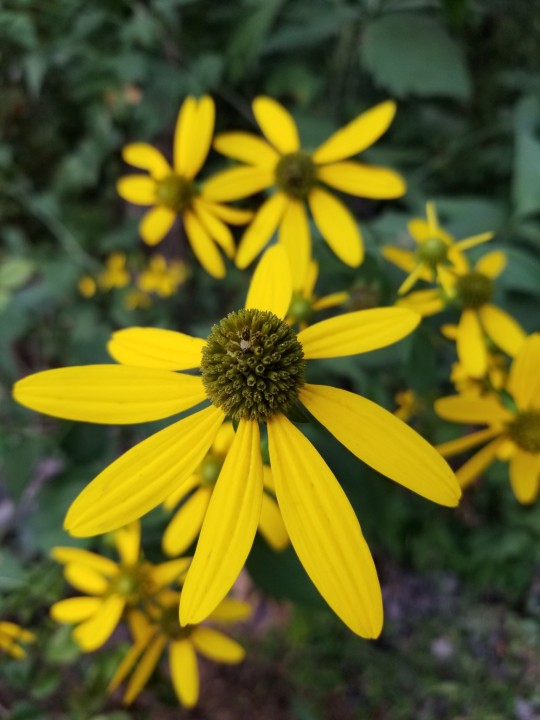
Summer's End
Henrico County, Virginia (USA)
Photo from August 30, 2020.
Along the banks of a local stream, I found a lovely patch of Green-headed Coneflowers. They're a North American wildflower that you may encounter along stream banks, or in floodplains or moist woods. They're a Rudbeckia species like Black-eyed Susans, hence a family resemblance.
74 notes
·
View notes
Text
Red dead gang + flowers
Arthur Morgan - Dudleya cymosa; Canyon liveforever, native to California cliff faces and craggy areas, thrives in the sun and blooms vibrant red and orange cymes. Pointed rosettes of succulent leaves form the base which sends out a delicate bloom in early summer. This flower is also the one found in the terrarium jar on Arthur's bedside table.
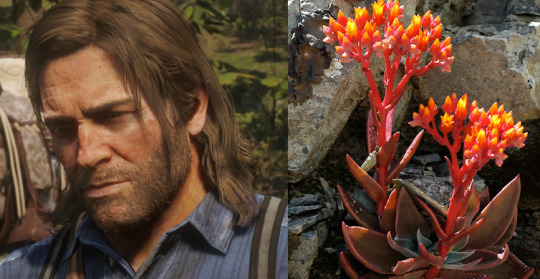
Tilly Jackson - Helianthus annuus; Common sunflower, a showy plant native to grasslands in the US, its undomesticated form is a branching annual plant with many flower heads. Its domesticated form is an important food crop grown both for its seeds and seed oil. It's common in sunny gardens, where its unmistakable bright blooms attract pollinators. Commonly symbolizes longevity and adoration.

Sean Maguire - Tripolium pannonicum; Sea aster, native to Ireland, a very hardy plant that requires very little to thrive. Showy purple blooms usually a bit ruffled, but all the brighter in their seaside environments.
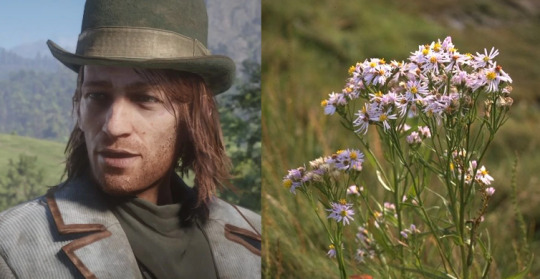
Charles Smith - Quercus alba; White oak, a staple crop for thousands of years, white oaks of the Quercus genus are amongst the most important habitat species for wildlife in North America. These trees provide food, shelter, fuel, and fertilizer for countless native flora and fauna, and oaks are among the few trees that thrive in both open fields and sheltered forests. Their diminuitive flowers (catkins) are wind pollinated and mature into thousands of acorns per tree every 2-10 years. Traditionally associated with bounty, wisdom, and protection. (Not a flower in the traditional sense, but catkins do count and white oak really REALLY suited Charles so I'm putting this in)
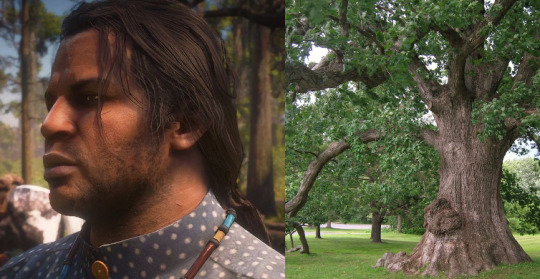
Dutch Van Der Linde - Pueraria montana; Kudzu vine, a hardy, subtropical plant introduced to the US with bright sweet pea flower spikes in spring. Rapidly spreads to completely cover native flora, shading out and crushing plants and depleting habitat for mutualistic wildlife. This vine is a noxious invasive in the southern US.
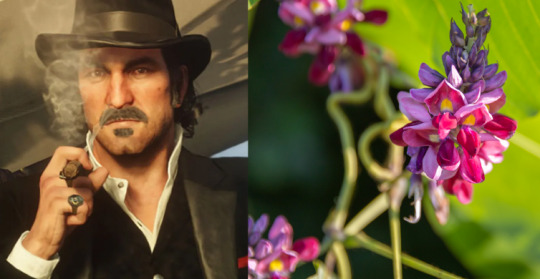
Hosea Matthews - Triticum aestivum; Wheat, grown as a staple crop around the world, wheat has many uses and is considered the backbone of western cuisine. Often grown in wide monocrop fields, mature wheat's golden color makes for a striking image. Commonly symbolizes bounty and resurrection. (Yes, grass (Poaceae) is a flowering plant family!)

Mary-Beth Gaskill - Viola riviniana; Common dog violet, native to europe, its nodding purple blooms can be found along roads and creeks in lightly shaded areas. Flowers in this genus traditionally symbolize modesty and humility.

Abigail Roberts/Marston - Rudbeckia hirta; Black-eyed Susan, a popular midwest native wildflower common in gardens for its sunny florets and contrasting center. Its association with gardening is a long established one, and traditionally symbolizes encouragement, adaptability, and determination.
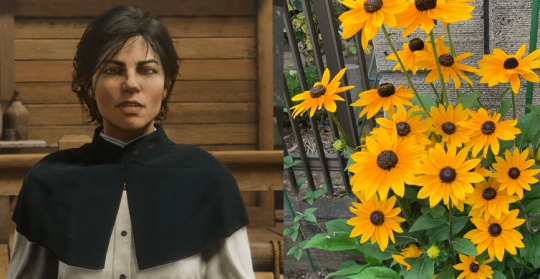
Molly O'Shea - Passiflora alata; Winged-stem passionflower, a species native to the south American tropics and known for its visually distinctive red petals and exotic striped filaments. A delicate looking nodding flower with an edible fruit, commonly cultivated for its medicinal benefits and its beauty.
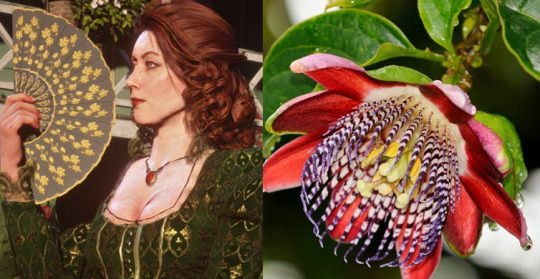
This post got very long! I will make a part two to save you the effort of scrolling <3
#rdr2#Red Dead Redemption 2#Botany#Long post#Arthur Morgan#Tilly Jackson#Sean Macguire#Dutch van der Linde#Hosea Matthews#Mary Beth Gaskill#Abigail Roberts#Molly O'Shea#*combines my two special interests*
322 notes
·
View notes
Text
Michigan lilies (Lilium michiganensis)
These are from my garden. Unedited. They're also the real deal. Not a cultivar, not a hybrid. They really grow like this in the wild.

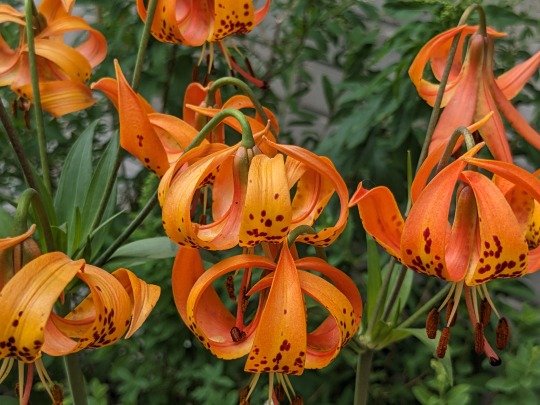

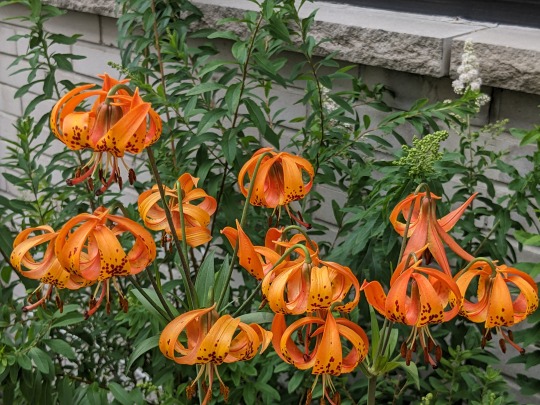







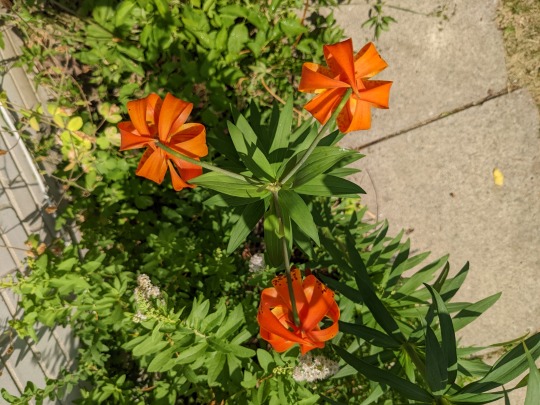
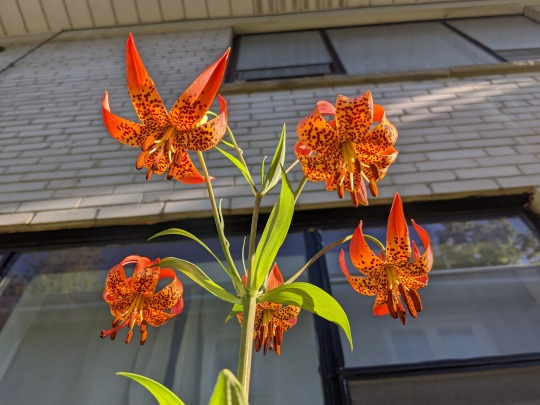

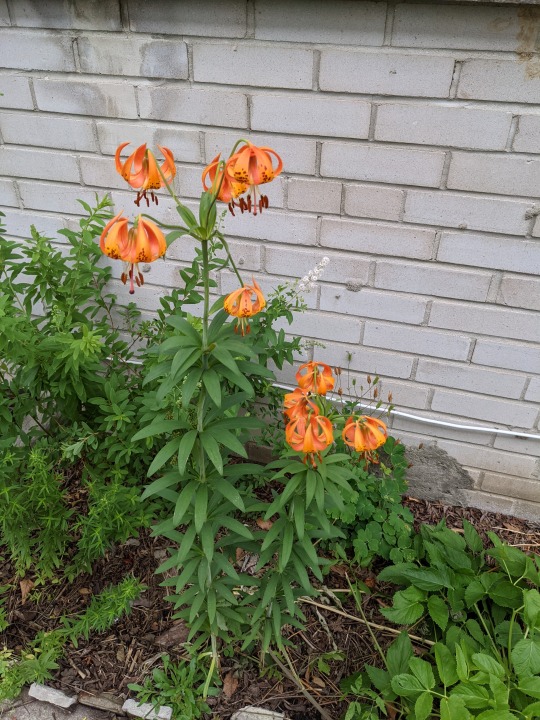
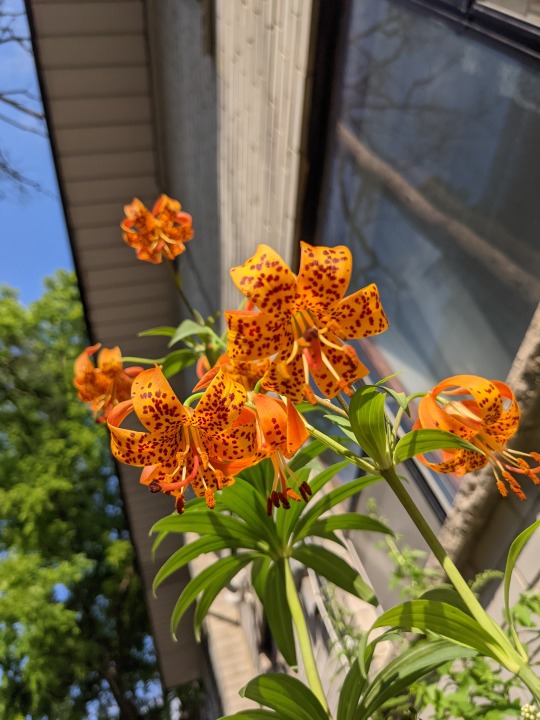
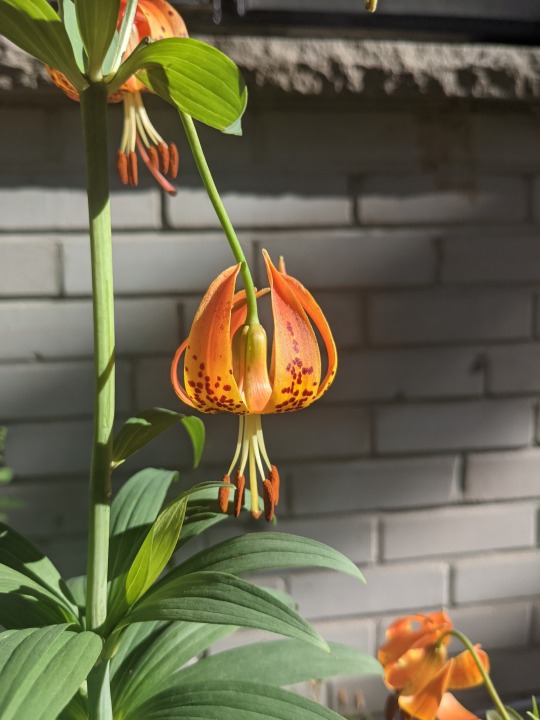



They bloom in June and spread slowly but exponentially. Flower petals and bulbs are edible cooked (all parts are toxic to cats and dogs though). :)
#photography#my photos#blackswallowtailbutterfly#Michigan lily#Lilium michiganensis#flowers#lilies#true lilies#orange flowers#wildflowers#gardening#native species#North American native plants#edible wild plants#my garden#native plants of Ontario and the northeastern USA
7 notes
·
View notes
Text
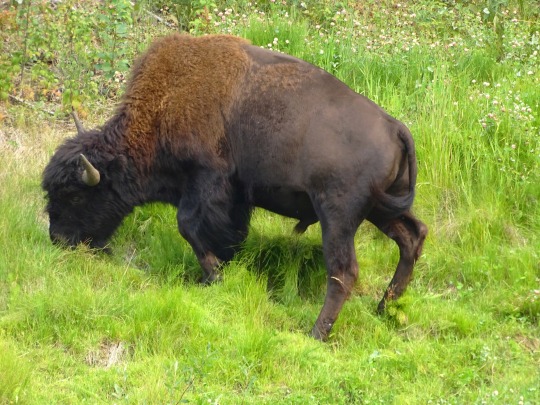
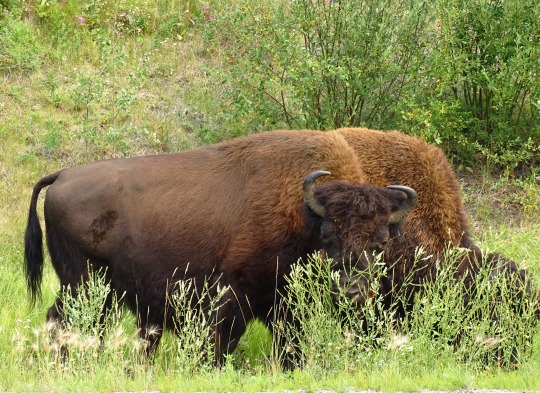
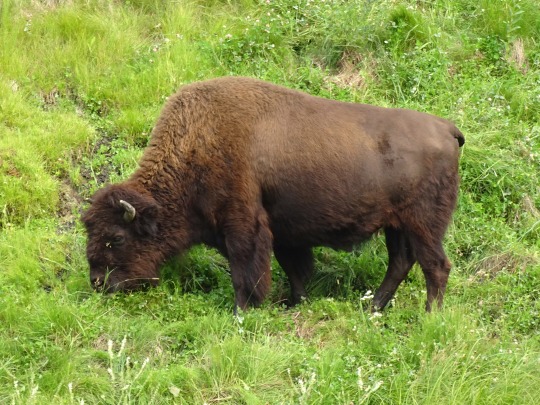

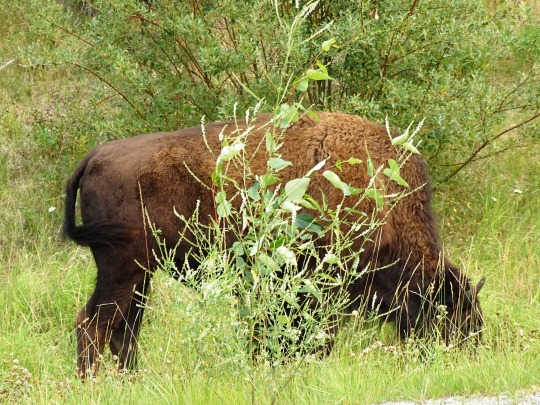




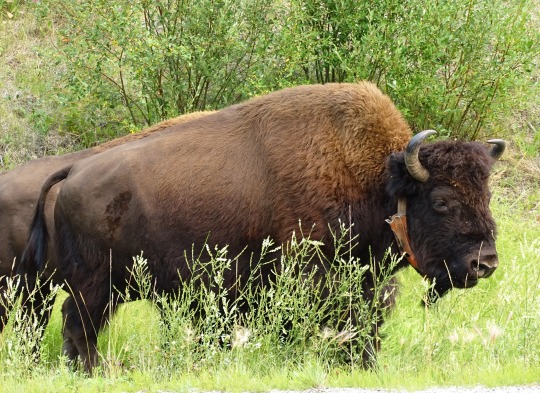
Wood Bisons, YT (No. 1)
The wood bison (Bison bison athabascae) or mountain bison (often called the wood buffalo or mountain buffalo), is a distinct northern subspecies or ecotype of the American bison. Its original range included much of the boreal forest regions of Alaska, Yukon, western Northwest Territories, northeastern British Columbia, northern Alberta, and northwestern Saskatchewan.
The term "buffalo" is considered to be a misnomer for this animal, as it is only distantly related to either of the two "true buffalo", the Asian water buffalo and the African buffalo. However, "bison" is a Greek word meaning an ox-like animal, while "buffalo" originated with the French fur trappers who called these massive beasts bœufs, meaning ox or bullock—so both names, "bison" and "buffalo", have a similar meaning. Though the name "bison" might be considered to be more scientifically correct, the name "buffalo" is listed in many dictionaries as an acceptable alternative for American bison. In reference to this animal, the term "buffalo" dates to 1635 in North American usage when the term was first recorded for the American mammal. It thus has a longer history than the term "bison", which was first recorded in 1774.
The "eastern bison" (B. b. pennsylvanicus) from the eastern United States, a junior synonym of B. b. bison had been called "wood(s) bison" or "woodland bison", not referring to B. b. athabascae.
Source: Wikipedia
#Wood Bison#Alaska Highway#travel#original photography#vacation#landmark#landscape#countryside#summer 2023#flora#nature#Canada#Alaska-Canadian Highway#ALCAN Highway#Alaskan Highway#the North#Yukon#mural#tourist attraction#fauna#wildlife#animal#grazing#meadow#Bison bison athabascae#mountain bison#wood buffalo#mountain buffalo#American bison#wildflower
7 notes
·
View notes
Photo

April: Pink Moon
April has the Full Pink Moon, from the pink phlox wildflowers that bloom in North America in the early spring. The Native American names referred to the spring thaws and the return of growth, including Breaking Ice Moon and The Moon of the Red Grass Appearing.Common names in Europe also referred to the budding and birth of spring: The Anglo-Saxons called it Egg Moon, the Celts had names like Budding Moon, New Shoots Moon, Seed Moon, and Growing Moon. A Neo-Pagan name is Awakening Moon.The sun watches what I do, but the moon knows all my secrets.
146 notes
·
View notes
Text
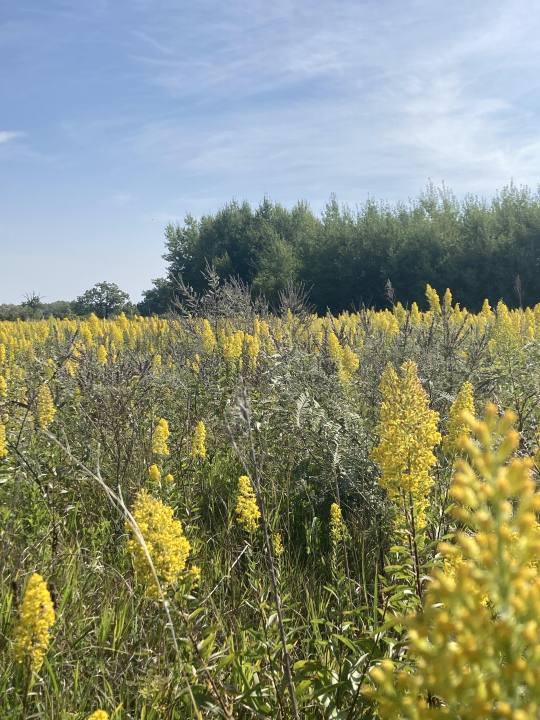
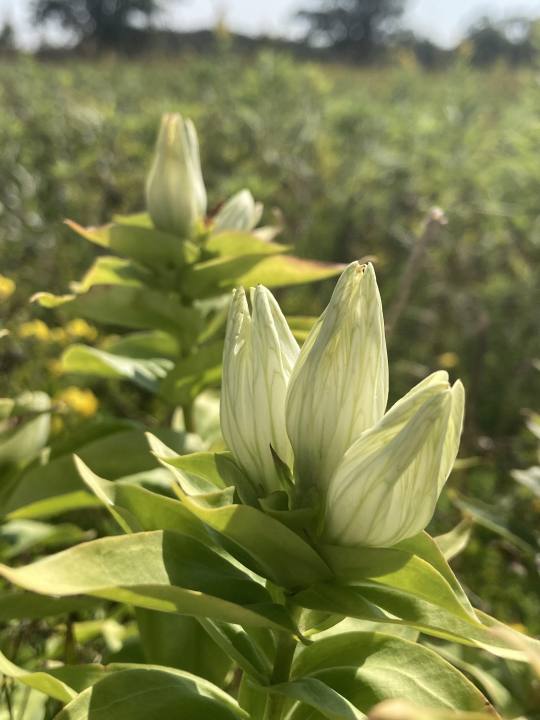
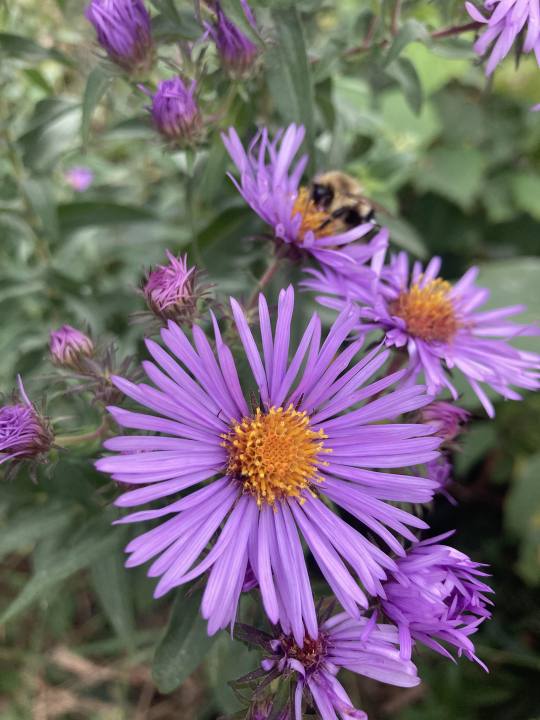
you say gatsby season, i say what the fuck are you talking about, it's prairie time!!!
My photos: September 2023
#prairie#goldenrod#new england aster#gentiana#wildflower photography#botany#plantblr#original photography on tumblr#bumblebees#midwestern flora#north american flora
4 notes
·
View notes
Photo



Verbena hastata (blue vervain) and Apis mellifera (European honey bee)
A taste of honey
Blue vervain is a common North American wildflower that is to be seen throughout the continental United States and in much of southern Canada. This plant prefers wet, open field habitats and riverine environments. In these photos, it’s being pollinated by a European honey bee (first introduced to North America in 1622).
To produce a 16 ounce jar of honey requires a lot of effort. According to the Canadian Honey Council. each jar contains the nectar of between one and two million flowers (different plant species vary in the amount of nectar they produce). A single honey bee will collect one teaspoon of nectar during it’s life. Most nectar contains 70% water but this must be reduced to less than 17% to make honey. A honey bee lives about six weeks and a pound of honey represents the entire lifetime’s labor of between 550 and a thousand worker bees. These bees musty fly over 55,000 miles (twice the circumference of the Earth!) to make a single jar of honey. You may want to consider these amazing facts the next time you put honey on your toast.
#flowers#photographers on tumblr#blue vervain#honey bee#honey#fleurs#flores#fiori#blumen#bloemen#Vancouver
106 notes
·
View notes